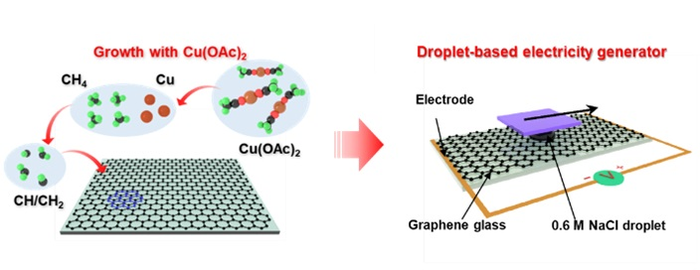An effective method formulated by a team of researchers employs a metal-containing species, copper acetate, to uninterruptedly deliver copper clusters in a gaseous form to support transfer-free growth of graphene on wafer-scale insulators.
 Left panel: Schematic illustration of the graphene growth process with the presence of Cu(OAc)2. Right panel: Schematic illustration of the device set-up for electricity generation. (Image Credit: ©Science China Press).
Left panel: Schematic illustration of the graphene growth process with the presence of Cu(OAc)2. Right panel: Schematic illustration of the device set-up for electricity generation. (Image Credit: ©Science China Press).
The study was headed by Prof. Zhongfan Liu (Center for Nanochemistry, College of Chemistry and Molecular Engineering, Peking University), Prof. Wanlin Guo (State Key Laboratory of Mechanics and Control of Mechanical Structures, Institute of Nanoscience, Nanjing University of Aeronautics and Astronautics), and Prof. Jingyu Sun (College of Energy, Soochow Institute for Energy and Materials InnovationS, Soochow University).
As-grown graphene films freely exhibited diminished multilayer density, enhanced electrical performance and progressive carrier mobility value. In addition, droplet-based hydrovoltaic electricity generator devices established on directly grown graphene were said to display strong voltage output and extended cyclic stability, signifying its potential for upcoming energy harvesting applications.
Direct synthesis of superior quality graphene on dielectric substrates without a transfer procedure is of vital significance to aim at a range of applications. But, directly grown graphene films are inclined to suffer from low crystal quality, numerous structural flaws and simultaneous formation of multilayers, which would lead to poor optical/electrical properties, which hamper high-end applications.
Recent strategies for improving high-quality graphene growth, such as remote metal catalyzation, otherwise are restricted by poor performance concerning the release of metal catalysts and thus suffer from the problem of metal dregs.
Herein, they described an effective method that employs a metal-containing species, copper acetate, to uninterruptedly deliver copper clusters in a gaseous form to support transfer-free growth of graphene over a wafer scale. Cu(OAc)2 was exposed to volatilization using a separate heating system to allow the supply of Cu clusters.
The derived Cu clusters facilitate effective decomposition of the CH4 precursor by decreasing its activation energy, as shown by density functional theory calculations. The graphene films displayed carrier mobility of 8500 cm2 V−1 s−1.
As a proof-of-concept, the team showed the making of a hydrovoltaic electricity generator device using thus-grown graphene. As-constructed generator exhibited excellent voltage output and cyclic stability compared to its transfer-involving graphene equivalents, holding promise for real-world applications.
The study illustrated here provides a favorable solution to arrange the metal catalytic booster toward the transfer-free synthesis of superior quality graphene and facilitate smart energy generation.
Journal Reference:
Shan, J., et al. (2021) Copper acetate-facilitated transfer-free growth of high-quality graphene for hydrovoltaic generators.National Science Review. doi.org/10.1093/nsr/nwab169.